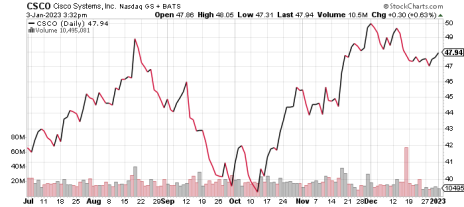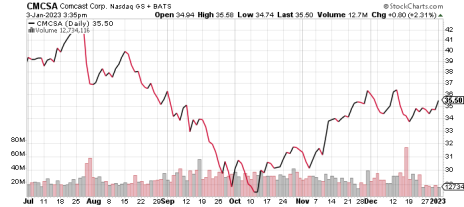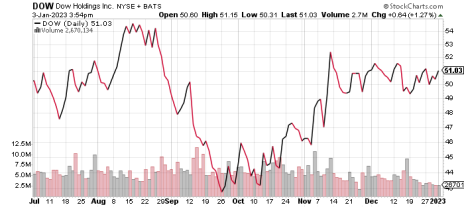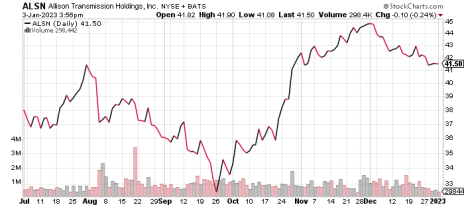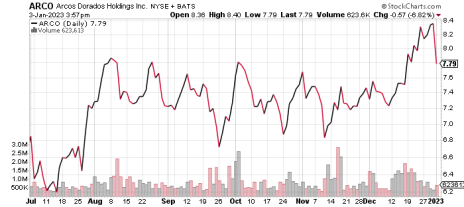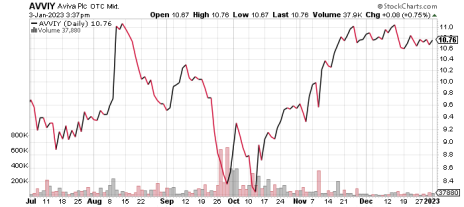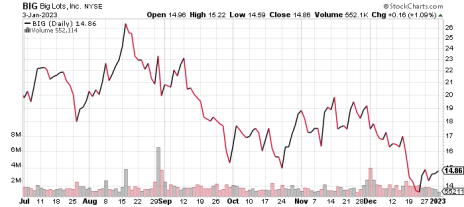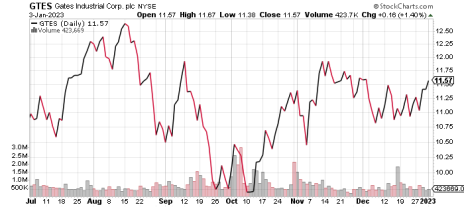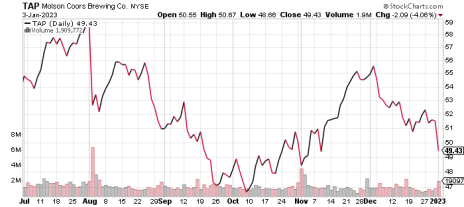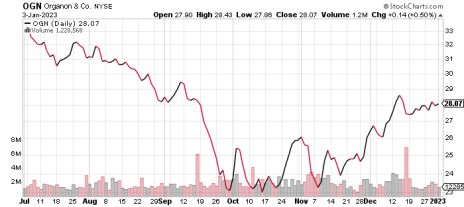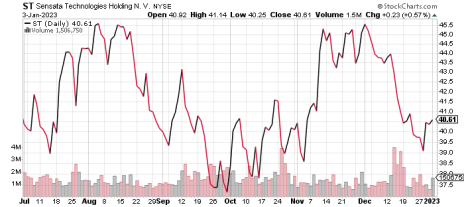Thoughts Going Into 2023
The investing world has certainly changed from a year ago. In late 2021, asset prices were surging to all-time highs as investors were optimistic that prosperous conditions would continue indefinitely. Today, asset prices across the board are sharply lower as investors worry about inflation, recessions and war. With the shift in the investing climate, the S&P 500 returned negative 19.4% last year, with the tech-heavy Nasdaq Composite producing a negative 33.0% return. Surprisingly, the relatively bland Dow Jones Industrial Average total return index fell only 6.9%, as much of the sell-down was focused on fast-growing but over-hyped and earnings-resistant concept stocks and mega-cap tech stocks.
While the front end of hype cycles can produce exhilarating profits and new billionaires (and help fund awe-inspiring innovations – think “Internet 2022” vs. “Internet 1999”), the back end of the cycle can quickly unravel the fortunes of the new billionaires and regular folks alike. Investors with losses can take solace in the knowledge that no matter how bad their losses were, their year was vastly better than the wealth implosions experienced by Sam Bankman-Fried (lost all of his $26 billion fortune) and Elon Musk (lost $110 billion).
Yet, despite the weak results last year, the S&P 500 has generated a 7.7% annualized rate of return over the past three years and an impressive 12.6% annualized rate of return over the past 10 years. Curiously, the Dow Jones Industrial Average – often maligned as stodgy and irrelevant – has held its own, producing 3-year and 10-year rates of return that are almost spot-on with those of the S&P 500.
Fixed income returns were disappointing, as rising interest rates depressed the value of these securities. Investment grade corporate bonds produced a 15.2% loss – one of the worst losses on record and a shock to the 60/40 allocation that was supposed to provide diversification against market downturns.
Keeping in mind our favorite quote about forecasts, spoken by the linguistically creative baseball legend Yogi Berra, “predictions are difficult, especially about the future,” we describe below our outlook for 2023. We use our outlook as more of a general model than a high conviction posture, along the lines of a quote attributed to statistician George Box, “All models are wrong, but some models are useful.”
We see 2022 as a bridge year, in which capital markets and the economy crossed over from an overstimulated, low-inflation pandemic era to a less accommodative and elevated inflation post-pandemic era. It might take much or all of 2023 to completely cross this bridge, as companies, capital markets and the economy likely need more time to fully adjust and as the knock-on effects make the task more complicated.
The geopolitical environment crossed its own bridge: from a generally peaceful era to a war era. Russia’s invasion of Ukraine brought outright war to Europe while countries in the Asia Pacific region grow worried about a possible Chinese attack against Taiwan. Countries around the world are re-arming, while more defined spheres of influence are developing. Unfortunately, in the long sweep of history, war and aggression, not peace, have been the norm.
Our outlook for the S&P 500 for 2023 is for a flat year. We see only modest if any earnings growth and limited change to the current 16.6x earnings multiple. The economy, in our view, will remain healthy enough to grow 2-3% (so, no recession) but elevated wages, interest expenses and other costs will likely crimp profit margins. We see market interest rates in general remaining about where they are, with the Fed raising rates perhaps by another 50-75 basis points but not cutting rates during 2023. As such, bond performance will likely be better than in 2022, with perhaps a single-digit positive return.
We see no (good) end to the Ukraine war, and worry that China, Iran, Russia, North Korea and other autocracies will continue to be disruptive forces, mostly in negative ways. But, the possibility exists for a radical positive change in any of these countries. Our “Two Easts” stratagem, in which Washington, D.C. (in the eastern U.S.) and China (the Far East) play an increasing role in securities and asset prices and the global environment, should remain in full effect, although our definition of “east” may need to be expanded to include eastern Europe.
All-in, we see 2023 as a year with many changes but also a year in which consumers, companies and countries – amazing sources of ingenuity and resolve – work their magic to adapt to whatever curve balls are thrown at them. Our optimism is undaunted.
Share prices in the table reflect Friday, December 30 closing prices. Please note that prices in the discussion below are based on mid-day January 3 prices.
Note to new subscribers: You can find additional color on past earnings reports and other news on recommended companies in prior editions and weekly updates of the Cabot Undervalued Stocks Advisor on the Cabot website.
Send questions and comments to Bruce@CabotWealth.com.
Today’s Portfolio changes
Arcos Dorados (ARCO) – Moving our rating from HOLD to SELL
Portfolio CHANGES SINCE LAST month
Arcos Dorados (ARCO) – Moving our rating from BUY to HOLD
Big Lots (BIG) – Reducing price target from 35 to 25
Growth & Income Portfolio
Growth & Income Portfolio stocks are generally higher-quality, larger-cap companies that have fallen out of favor. They usually have some combination of attractive earnings growth and an above-average dividend yield. Risk levels tend to be relatively moderate, with reasonable debt levels and modest share valuations.
Growth/Income Portfolio | |||||||
| Stock (Symbol) | Date Added | Price Added | 1/3/23 | Capital Gain/Loss | Current Dividend Yield | Price Target | Rating |
| Cisco Systems (CSCO) | 11/18/20 | 41.32 | 47.94 | 16.00% | 5.80% | 66 | Buy |
| Comcast Corp (CMCSA) | 10/26/22 | 31.5 | 35.57 | 12.90% | 3.40% | 42 | Buy |
| Dow Inc (DOW) * | 4/1/19 | 53.5 | 51.04 | -4.60% | 5.50% | 60 | Buy |
| State Street Corp (STT) | 8/17/22 | 73.96 | 78.4 | 6.00% | 3.20% | 94 | Buy |
| Stock (Symbol) | Current price | 2023 EPS Estimate | 2024 EPS Estimate | Change in 2023 Estimate | Change in 2024 Estimate | P/E 2023 | P/E 2024 |
| CSCO | 47.77 | 3.55 | 3.83 | 0.0% | 0.0% | 13.5 | 12.5 |
| CMCSA | 35.34 | 3.75 | 4.18 | 0.0% | 0.0% | 9.4 | 8.5 |
| DOW | 51.03 | 4.38 | 5.36 | 0.0% | 0.0% | 11.6 | 9.5 |
| STT | 79.57 | 8.37 | 9.51 | 0.1% | 0.1% | 9.5 | 8.4 |
Cisco Systems (CSCO) is facing revenue pressure as customers migrate to the cloud and thus need less of Cisco’s equipment and one-stop-shop services. Cisco’s prospects are starting to improve under a relatively new CEO, who is shifting Cisco toward a software and subscription model and is rolling out new products, helped by its strong reputation and entrenched position within its customers’ infrastructure. The company is highly profitable, generates vast cash flow (which it returns to shareholders through dividends and buybacks) and has a very strong balance sheet.
Cisco may, at the margin, be negatively impacted by changes in Federal income tax laws that took effect on January 1. IRS rules previously allowed businesses to deduct 100% of the cost of new equipment under the “bonus depreciation” rule. This rule is primarily designed to help small and medium-sized businesses. Starting this year, the bonus deprecation rate is reduced to 80%, then ramps down to zero starting in 2027. Some of Cisco’s customers may have increased their tech purchases last year in advance of the phase-out, which may at the margin reduce Cisco’s 2023 revenues.
CSCO shares rose 1% for the week and have 38% upside to our 66 price target. The valuation is attractive at 9.4x EV/EBITDA and 13.5x earnings per share. The 3.2% dividend yield adds to the appeal of this stock. BUY
Comcast Corporation (CMCSA) – With $120 billion in revenues, Comcast is one of the world’s largest media and entertainment companies. Its properties include Comcast cable television, NBCUniversal (movie studios, theme parks, NBC, Telemundo and Peacock), and Sky media. The Roberts family holds a near-controlling stake in Comcast. Comcast shares have tumbled as worry about cyclical and secular declines in advertising revenues and a secular decline in cable subscriptions as consumers shift toward streaming services, as well as rising programming costs and incremental competitive pressure as phone companies upgrade their fiber networks.
However, Comcast is a well-run, solidly profitable and stable company that will likely continue to successfully fend off intense competition while increasing its revenues and profits, as it has for decades. The company generates immense free cash flow which is more than enough to support its reasonable debt level, pay a generous dividend (recently raised 8%) and sizeable share buybacks.
Total North American box office revenue in 2022 was weak, at $7.2 billion, compared to a typical pre-pandemic year of $11 billion. Growing popularity of streaming services, some lingering Covid concerns and a lack of supply of high-demand movies weighed on 2022 revenues.
Comcast’s Universal Studios had a relatively good year, earning the #2 rank with $1.6 billion in domestic revenues. The company held the top spot for number of releases, at 36. “Jurassic World: Dominion” and “Minions: The Rise of Gru” were notable winners for Universal Studios. Disney held the top ranking with $1.8 billion in domestic revenues.
The industry’s 2023 outlook is encouraging. Better-structured shooting and production schedules, an improved roster of movies, a normalized release cadence and lower Covid concerns should bring better revenues to the industry and Universal Studios.
Comcast shares were recommended in several publications including Barron’s as a strong stock for 2023. We appreciate the support.
Comcast shares rose 1% for the past week and have 19% upside to our 42 price target. The shares offer an attractive 3.1% dividend yield. BUY
Dow Inc. (DOW) is the world’s largest producer of ethylene and polyethylene, the most widely used plastics. Investors undervalue Dow’s hefty cash flows and sturdy balance sheet largely due to its uninspiring secular growth traits, its cyclicality and concern that management will squander its resources. The shares are driven by: 1) commodity plastics prices, which are often correlated with oil prices and global growth, along with competitors’ production volumes; 2) volume sold, largely driven by global economic conditions, and 3) ongoing efficiency improvements (a never-ending quest of all commodity companies). Recent concerns about a recession have send Dow shares to well below our estimate of their fair value, even as the company’s long-term prospects and ability to maintain its dividend are attractive. Dow shares are a recommended Buy in our sister publication the Cabot Turnaround Letter.
There was no significant company-specific news in the past week.
Dow shares were flat in the past week and have 18% upside to our 60 price target (same as in the Cabot Turnaround Letter). The quarterly dividend appears readily sustainable and provides an appealing 5.5% yield. The shares trade at a modest 6.5x EV/EBITDA multiple and 11.6x EPS on recession-minded 2023 estimates. BUY
State Street Corporation (STT) – State Street is the world’s largest custodian bank, with $38 trillion in assets under custody/administration. About 56% of its revenues are produced from custody, client reporting, electronic trading and full enterprise solutions services for investment managers. The balance is produced from investment management fees on ETFs, foreign exchange fees, securities financing fees and net interest income. The industry has combined into four dominant firms due to economies of scale. State Street’s shares are out of favor and unchanged since 2007 due to concerns over its anemic growth and steady pricing pressure from competitors. However, we see State Street as a solid, well-capitalized franchise that provides critical services, with a slow-growth but steady revenue and earnings stream. Our interest in STT shares is that we can buy them at an attractive valuation. We also find the dividend yield appealing.
There was no significant company-specific news in the past week.
State Street shares rose 3% in the past week and have 18% upside to our 94 price target. The company’s dividend (3.2% yield) is well-supported and backed by management’s strong commitment. BUY
Buy Low Opportunities Portfolio
Buy Low Opportunities Portfolio stocks include a wide range of value opportunities. These stocks carry higher risk than our Growth & Income stocks yet also offer more potential upside. This group may include stocks across the quality and market cap spectrum, including those with relatively high levels of debt and a less-clear earnings outlook. The stocks may not pay a dividend. In all cases, the shares will trade at meaningful discounts to our estimate of fair value.
Buy Low Opportunities Portfolio | |||||||
| Stock (Symbol) | Date Added | Price Added | 1/3/23 | Capital Gain/Loss | Current Dividend Yield | Price Target | Rating |
| Allison Transmission Hldgs (ALSN) | 2/22/22 | 39.99 | 41.51 | 3.80% | 2.00% | 48 | Buy |
| Arcos Dorados (ARCO) | 4/28/21 | 5.41 | 7.78 | 43.80% | 2.10% | 8.5 | SELL |
| Aviva (AVVIY) | 3/3/21 | 10.75 | 10.76 | 0.10% | 5.20% | 14 | Buy |
| Barrick Gold (GOLD) | 3/17/21 | 21.13 | 17.83 | -15.60% | 2.20% | 27 | Buy |
| BigLots (BIG) | 4/12/22 | 35.24 | 14.86 | -57.80% | 8.10% | 25 | HOLD |
| Citigroup (C) | 11/23/21 | 68.1 | 45.78 | -32.80% | 4.50% | 85 | Buy |
| Gates Industrial Corp (GTES) | 8/31/22 | 10.71 | 11.57 | 8.00% | 0.00% | 14 | Buy |
| Molson Coors (TAP) | 8/5/20 | 36.53 | 49.44 | 35.30% | 3.10% | 69 | Buy |
| Organon (OGN) | 6/7/21 | 31.42 | 28.07 | -10.70% | 4.00% | 46 | Buy |
| Sensata Technologies (ST) | 2/17/21 | 58.57 | 40.61 | -30.70% | 1.10% | 75 | Buy |
| Stock (Symbol) | Current price | 2023 EPS Estimate | 2024 EPS Estimate | Change in 2023 Estimate | Change in 2024 Estimate | P/E 2023 | P/E 2024 |
| 41.78 | 5.86 | 6.51 | 0.0% | 0.0% | 7.1 | 6.4 | |
| ARCO | 8.18 | 0.66 | 0.82 | 0.0% | 0.0% | 12.4 | 9.9 |
| AVVIY | 10.74 | 0.55 | 0.63 | 0.0% | 0.0% | 19.5 | 17.2 |
| GOLD | 17.73 | 0.78 | 0.95 | 0.5% | 0.5% | 22.7 | 18.7 |
| BIG | 15.21 | (0.68) | 1.67 | 1.5% | 0.0% | (22.4) | 9.1 |
| C | 46.70 | 6.66 | 7.51 | -1.0% | -0.4% | 7.0 | 6.2 |
| GTES | 11.57 | 1.17 | 1.31 | 0.0% | 0.0% | 9.9 | 8.8 |
| TAP | 49.50 | 4.09 | 4.37 | -0.4% | 0.0% | 12.1 | 11.3 |
| OGN | 28.33 | 4.78 | 5.20 | 0.0% | 0.0% | 5.9 | 5.4 |
| ST | 40.85 | 3.68 | 4.37 | 0.0% | 0.0% | 11.1 | 9.4 |
Allison Transmission Holdings, Inc. (ALSN) – Allison Transmission is a midcap manufacturer of vehicle transmissions. While many investors view this company as a low-margin producer of car and light truck transmissions that is destined for obscurity in an electric vehicle world, Allison actually produces no car or light truck transmissions. Rather, it focuses on the school bus and Class 6-8 heavy-duty truck categories, where it holds an 80% market share. Its EBITDA margin is sharply higher than its competitors and on-par with many specialty manufacturers. And, it is a leading producer and innovator in electric axles which all electric trucks will require. The company generates considerable free cash flow and has a low-debt balance sheet. Its capable leadership team keeps its shareholders in mind, as the company has reduced its share count by 38% in the past five years.
There was no significant company-specific news in the past week.
ALSN shares slipped 1% in the past week and have 15% upside to our 48 price target. The stock pays a respectable and sustainable 2.0% dividend yield. BUY
Arcos Dorados Holdings (ARCO), which is Spanish for “golden arches,” is the world’s largest independent McDonald’s franchisee. Based in stable Uruguay and listed on the NYSE, the company produces about 72% of its revenues in Brazil, Mexico, Argentina and Chile. At our recommendation date, the shares were depressed as investors worried about the pandemic, political/social unrest, inflation and currency devaluations. However, the company has a solid brand, high recurring demand, impressive leadership (including founder/chairman who owns a 38% stake) and successful experience in navigating local conditions, along with a solid balance sheet and free cash flow.
Given the limited upside in Arcos shares and the risks from a weaker currency, the risk-return trade-off is now unfavorable. We are moving our rating from Hold to Sell. Our decision is not based on the company’s fundamentals (they remain impressively strong, the leadership is high quality, and its McDonald’s franchise is among the best-positioned and highest-value in the world), but rather on the risk/return profile embedded in the current share price.
Since our initial recommendation in April 2021, the shares have produced approximately a 51% total return compared to a negative (-6%) total return for the S&P 500 over this period. SELL
Aviva, plc (AVVIY), based in London, is a major European company specializing in life insurance, savings and investment management products. Amanda Blanc, hired as CEO in July 2020, is revitalizing Aviva’s core UK, Ireland and Canada operations following her divestiture of other global businesses. The company now has excess capital which it is returning to shareholders as likely hefty dividends following a sizeable share repurchase program. We expect that activist investor Cevian Capital, which holds a 5.2% stake, will keep pressuring the company to maintain shareholder-friendly actions.
There was no significant company-specific news in the past week.
Aviva shares were flat in the past week and have 30% upside to our 14 price target. Based on management’s estimated dividend for 2023, the shares offer a generous 7.1% yield. BUY
Barrick Gold (GOLD), based in Toronto, is one of the world’s largest and highest quality gold mining companies. About 50% of its production comes from North America, with the balance from Africa/Middle East (32%) and Latin America/Asia Pacific (18%). Barrick will continue to improve its operating performance (led by its highly capable CEO), generate strong free cash flow at current gold prices, and return much of that free cash flow to investors while making minor but sensible acquisitions. Also, Barrick shares offer optionality – if the unusual economic and fiscal conditions drive up the price of gold, Barrick’s shares will rise with it. Given their attractive valuation, the shares don’t need this second (optionality) point to work – it offers extra upside. Barrick’s balance sheet has nearly zero debt net of cash. Major risks include the possibility of a decline in gold prices, production problems at its mines, a major acquisition and/or an expropriation of one or more of its mines.
There was no significant company-specific news in the past week.
Over the past week, commodity gold lifted 2% to 1,844/ounce. The commodity was essentially flat in 2022 as rising interest rates depressed its appeal and as the U.S. dollar was impressively strong. Early 2023 optimism that the Fed will relent on its rate hike campaign plus expectations for further weakness in the dollar are helping gold prices. The 10-year Treasury yield ticked up to 3.77% while the US Dollar Index, another driver of gold prices (the dollar and gold usually move in opposite directions), was unchanged at 104.41.
Investors and commentators offer a wide range of outlooks for the economy, interest rates and inflation. We have our views but hold these as more of a general framework than a high conviction posture (see our opening commentary). Investing in gold-related equities is a long-term decision – investors shouldn’t allow near-term weakness to deter their resolve.
Barrick shares were flat in the past week and have 52% upside to our 27 price target. Our resolve with Barrick shares remains undaunted through the recent sell-off. BUY
Big Lots (BIG) – Big Lots is a discount general merchandise retailer based in Columbus, Ohio, with 1,431 stores across 47 states. Its stores offer an assortment of furniture, hard and soft home goods, apparel, electronics, food and consumables as well as seasonal merchandise. Our initial case for Big Lots rested with its loyal and growing base of 22 million rewards members, its appeal to bargain-seeking customers, the relatively stable (albeit low) cash operating profit margin, its positive free cash flow, debt-free balance sheet and low share valuation. Our thesis was deeply rattled by the company’s surprisingly large inventory glut in the first quarter 2022, likely burdening it with new and permanent debt.
There was no significant company-specific news in the past week.
Big Lots shares remain high-risk due to the permanent debt balance and the likelihood of a suspension of the dividend.
We reiterate our view that Big Lots shareholders who are not willing or able to sustain further losses in the shares should sell now. There is no reasonably definable floor to a stock like Big Lots when fundamentals and valuation are ignored while investors reduce their risk exposure.
Big Lots shares gained 2% this past week and have 64% upside to our revised 25 price target. The shares offer a 7.9% dividend yield, although, as noted, investors should not rely on this dividend being sustained. HOLD
Citigroup (C) – Citi is one of the world’s largest banks, with over $2.4 trillion in assets. The bank’s weak compliance and risk-management culture led to Citi’s disastrous and humiliating experience in the 2009 global financial crisis, which required an enormous government bailout. The successor CEO, Michael Corbat, navigated the bank through the post-crisis period to a position of reasonable stability. Unfinished, though, is the project to restore Citi to a highly-profitable banking company, which is the task of new CEO Jane Fraser.
There was no significant company-specific news in the past week.
This past week, the yield spread between the 90-day T-bill and the 10-year Treasury bond, which approximates the drivers behind Citi’s net interest margin, widened fractionally to negative 60 basis points (100 basis points in one percentage point). This spread remains nearly the widest since at least the early 1980s. Our interpretation is that investors are assuming that the Fed rate hikes and other macro drivers will drag down inflation to sub-5% or so this year. Given that the inflation metrics are flattening out or declining, this assumption seems reasonable.
Citi shares trade at 58% of tangible book value and 7.0x estimated 2023 earnings. The remarkably low valuations assume an unrealistically dim future for Citi.
Citi shares rose 5% in the past week and have 82% upside to our 85 price target. Citigroup investors enjoy a 4.4% dividend yield. We anticipate that the bank is done with share buybacks until there is more clarity on the economic and capital market outlook, which could readily be a year or more away. BUY
Gates Industrial Corp, plc (GTES) – Gates is a specialized producer of industrial drive belts and tubing. While this niche might sound unimpressive, Gates has become a leading global manufacturer by producing premium and innovative products. Its customers depend on heavy-duty vehicles, robots, production and warehouse machines and other equipment to operate without fail, so the belts and hydraulic tubing that power these must be exceptionally reliable. Few buyers would balk at a reasonable price premium on a small-priced part from Gates if it means their million-dollar equipment keeps running. Even in automobiles, which comprise roughly 43% of its revenues, Gates’ belts are nearly industry-standard for their reliability and value. Helping provide revenue stability, over 60% of its sales are for replacements. Gates is well-positioned to prosper in an electric vehicle world, as its average content per EV, which require water pumps and other thermal management components for the battery and inverters, is likely to be considerably higher than its average content per gas-powered vehicle.
The company produces wide EBITDA margins, has a reasonable debt balance and generates considerable free cash flow. The management is high-quality. In 2014, private equity firm Blackstone acquired Gates and significantly improved its product line-up and quality, operating efficiency, culture and financial performance. Gates completed its IPO in 2018, with Blackstone retaining a 63% stake today.
There was no significant company-specific news in the past week.
GTES shares rose 3% in the past week and have 21% upside to our 14 price target At the current price and based on estimated 2022 results, the shares offer a 12% free cash flow yield (free cash flow divided by market cap). This is a sizeable discount to what the company is worth. BUY
Molson Coors Beverage Company (TAP) is one of the world’s largest beverage companies, producing the highly recognized Coors, Molson, Miller and Blue Moon brands as well as numerous local, craft and specialty beers. About two-thirds of its revenues come from the United States, where it holds a 24% market share. Investors worry about Molson Coors’ lack of revenue growth due to its relatively limited offerings of fast-growing hard seltzers and other trendier beverages. Our thesis for this company is straight-forward – a reasonably stable company whose shares sell at an overly-discounted price. Its revenues are resilient, it produces generous cash flow and is reducing its debt. A new CEO is helping improve its operating efficiency and expand carefully into more growthier products. The company recently re-instated its dividend.
There was no significant company-specific news in the past week.
TAP shares slipped 5% in the past week and have 39% upside to our 69 price target. The stock remains cheap, particularly on an EV/EBITDA basis, or enterprise value/cash operating profits, where it trades at 8.3x estimated 2023 results, still among the lowest valuations in the consumer staples group and below other brewing companies. BUY
Organon & Company (OGN), a spin-off from Merck, specializes in patented women’s healthcare products and biosimilars, and also has a portfolio of mostly off-patent treatments. It may eventually divest its Established Brands segment. The management and board appear capable as they work to boost internal growth augmented by modest-sized acquisitions. The company produces robust free cash flow, has modestly elevated debt and pays a reasonable dividend.
There was no significant company-specific news in the past week.
OGN shares rose 1% in the past week and have 62% upside to our 46 price target (using the same target as the Cabot Turnaround Letter). The shares offer an attractive 4.0% dividend yield. BUY
Sensata Technologies (ST) is a $3.8 billion (revenues) producer of nearly 47,000 highly engineered sensors used by automotive (60% of revenues), heavy vehicle, industrial and aerospace customers. About two-thirds of its revenues are generated outside of the United States, with China producing about 21%. Investors undervalue Sensata’s durable franchise. Its sensors are typically critical components that generally produce high profit margins. As the sensors’ reliability is vital to safety and performance, customers are reluctant to switch to another supplier that may have lower prices but also lower or unproven quality. Sensata has an arguably under-leveraged balance sheet and generates healthy free cash flow. The relatively new CEO will likely continue to expand the company’s growth potential through acquisitions. Electric vehicles are an opportunity as they expand Sensata’s reachable market.
There was no significant company-specific news in the past week.
ST shares rose 3% in the past week and have 84% upside to our 75 price target. Our price target looks optimistic in light of the broad market sell-off, but we will keep it for now, even as it may take longer for the shares to reach it. BUY
The next Cabot Undervalued Stocks Advisor issue will be published on February 7, 2023.

